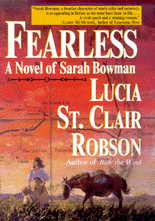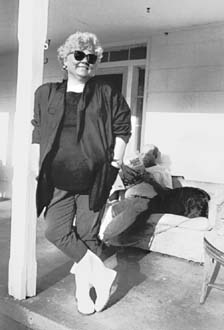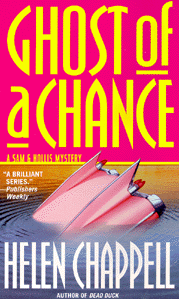
by Carol Glover
Heading for the beach? Packed your sunscreen and beach towel? How about some reading material?
For me, the beach means reading. One summer it was romance: heaving bosoms, heavy breathing and heartless lovers. Then it was mysteries: murder, mayhem and madness. One recent summer it was mind-stretching stuff, "the world's greatest literature." Now at mid-summer, I've found two books by Maryland authors, women whose styles are markedly different but who both tell a heck of a good story.
Lucia St. Clair Robson's 
Fearless, The Story of Sarah Bowman
Sarah Bowman, a frontier character of much color and notoriety, is as appealing in fiction as she must have been in life. A vivid epoch and a winning woman.
-Larry McMurtry, author of Lonesome Dove
"I always look for characters, people to drive my stories. The eventful, significant lives, ones you don't hear about a lot. That's why I write about women so often," Lucia St. Clair Robson tells me.
Robson, born in Baltimore and settled in Chesapeake Country's Severn River area, brings a scholarly background to her writing. Former Peace Corps volunteer, teacher and librarian, she writes novels rich in exotic place and deep in research. "My first book was researched like a term paper, from bibliography to bibliography. I use the Anne Arundel Library, their microfilm and computers. I also look for out-of-print material," she said.
So how did a librarian get to be in books in print? It sounds easy when she tells her story.
"In 1979 I was attending the Science Fiction Convention in Baltimore. While talking to Brian Daley, editor for DelRay, I mentioned my interest in Cynthia A. Parker [Robson's leading character in Ride the Wind, a story about the Comanches]. He encouraged me and told me to send in what I had. It was a Friday. I sent in the first six chapters and a synopsis of the story and character.
"I got a call from the editor the following week, 'Got your piece of trash today, just put in commas after the long introductory phrases and send it back.'
"I was offered a contract. I've been writing ever since."
After the success of Ride the Wind, Robson continued her saga of strong, independent women with Walk in My Soul, about the Cherokees and Sam Houston; Light a Distant Fire, which ventures into Florida; Tokaido Road, a novel of feudal Japan; and Mary's Land, a tale of Maryland's first settlements.
The latest Robson novel is Fearless, A Novel of Sarah Bowman. Set in Texas and Mexico, Robson revisits America's West after her recent foray into Maryland.
"I remembered reading about some Great Northern, Great Western, Great something," says Robson. "I found a monograph of her life and managed to get a copy just before it went out of print. I also looked through memoirs, people's personal accounts, finding pieces here and there. She was known as the Great Western after the biggest steamship."
Robson's meticulous research turned up the book Recollections of Some Rogue by Samuel Chamberlin. "On the cover is an illustration of Bowman, bosomy and standing at the bar holding a pistol," Robson says.
Six-foot-tall Sarah Bowman, a female Paul Bunyon type, was a laundress and cook during the Mexican-American War. Red-haired, witty and strong-willed, she chafed against the rigid codes imposed on women of the 1800s.
"Not much is known about Sarah, since she was lower class," says Robson. She learned, however, that her subject traveled with Zachary Taylor's army and during the fighting kept the cannon firing, rescued injured soldiers and provided a haven to children traveling with the troops.
Robson's story moves across her reconstructed landscape of 1880s' America, taking the reader from the Florida Everglades to Mexico. The scenes of war provide a backdrop to Sarah's saga, one of physical endurance against harsh terrain, insects and everyday calamities.
Part of Robson's story coincides with the St. Patrick's Brigade, the San Patricios, Irish deserters who fought against Taylor's army after being promised high pay, promotion and land by the Mexicans. Robson gives their popular story heartbreaking realism.
Following Sarah's adventures with the Mexican War, she traveled with the soldiers guarding the California gold-seekers. Stopping off in what is now El Paso, she owned and managed a hotel and eventually remarried.
To resurrect a living Sarah Bowman, Robson followed her to the grave. "I visited Sarah's grave," she told me. "She was originally buried at Fort Yuma, the only woman buried there with full military honors. But when all the graves were moved, she was reburied in the Presidio. Her bones were the biggest to make the journey. Now she has a great view on a slope in the Presidio in San Francisco."
Robson will be publicizing Sarah's story with readings and signings in July, first in Texas and then locally. We can meet her at Barnes & Noble on July 23, Waldenbooks in Annapolis Mall on July 25 and at other bookstores in the Baltimore area during late July and August.
So what eventful, significant life has caught Lucia St. Clair Robson's attention now?
The story of Lozen, an Apache woman, sister of Chief Victorio, the only single woman to ever ride with the men as a warrior. She was with Geronimo when he surrendered.
Says Robson, "I became interested in her when one of my friends in Western Writers mentioned her. Now I'm hooked. I go out West, read books on the Apaches and the flora and fauna of the area, the folk tales. I start with fact, flesh it out, fluff it up, figure out motivation and feelings. Diaries yield dialogue, as I try to learn period syntax and vocabulary, day-to-day life. I drive to the actual places. In this way I try to engage all the senses of the reader."
Lucia St. Clair Robson keeps her character list alphabetically on 4x6 cards. As she comes across each interesting person, she enters her name. Seems there'll be many more books to come.
Fearless: Meet Sarah
As the silhou ette neared, it separated into a horse and rider and a mule
carrying a small foothill of cargo. The mule veered from side to side, jerking
his lead rope taut to snatch at sweet blades of mesquite grass. That was
to be expected of a mule, whether he belonged to a Texan or a Mexican. Something
was odd about the rider's profile though. The shepherd squinted into the
late-summer glare.
ette neared, it separated into a horse and rider and a mule
carrying a small foothill of cargo. The mule veered from side to side, jerking
his lead rope taut to snatch at sweet blades of mesquite grass. That was
to be expected of a mule, whether he belonged to a Texan or a Mexican. Something
was odd about the rider's profile though. The shepherd squinted into the
late-summer glare.
!Dios mio! He crossed himself again.
Even though the woman was sitting, the shepherd could see that she was taller than most Texans. She rode astride the old Mexican saddle, her spacious skirt hiked to the thighs of legs that looked, to him, long enough to span a river. Her hips undulated in rhythm with the big sorrel mare's easy walk. Her thin cotton shirtwaist, soaked with perspiration, required nothing of the imagination as to how generous God had been in the creation of her. She had tied her cayenne-colored mane back under the crownless brim of a battered felt hat. Errant tendrils stuck up from the center of the brim like dark flames from a chimney.
The shepherd had never seen a colorada, a redheaded woman, before. He had no notion of whether she was a beauty or not, but he suspected she was. And she was bounteous by any definition. God was surely good from time to time.
She stuck the stocking she was knitting into a sack slung from the saddle skirt and reined the mare to a halt. If she had dismounted she would have stood chin and collarbone above the shepherd. She wiped her face with a bandana, rearranging the coating of red dust there.
"Hola." When she smiled, her teeth flashed white and even.
"Buenos dias, Señora," He removed his hat and held it to his chest. He might not recognize beauty in an anglo face, but he knew kindness when he saw it. Her wide, supple mouth, full lips, and startling green eyes were stamped with it.
Helen Chappell is one of the most creative and Helen
Chappell is one of the most creative and imaginative p eople
writing about the Delmarva region today.
eople
writing about the Delmarva region today.
-Tom Horton, Sun columnist and author of An Island Out of Time
Helen Chappell, Eastern Shore teacher and raconteur, has written close to 40 books, a mystery series, and articles for the Washington Post and Baltimore Sun, as well as the Oysterback Tales you've read in New Bay Times, among other places.
Talking with Chappell is like stepping into her latest book. She's chock full of reminiscences. Her humor and love of life come bursting forth as she talks about Ghost of a Chance, a story of an old crime come to light. Available in book stores now, it is the third in a series of mysteries featuring Sam Wescott, the dead ex-husband and his very much alive wife Hollis Ball, a local newspaper reporter. Their madcap partnership is made possible by the fact that Sam is now a ghost, whose main pastime is to haunt and bedevil Hollis.
Their association with a soap opera prima donna (Chappell was a soap opera staff writer 20 years ago), an Eastern Shore chicken king, watermen and other down home folks provide local color and great good fun. "I build lives for my characters," Chappell says, "but they soon take on a life of their own."
Chappell gets her ideas from local newspapers. "I'm interested in taking mundane things and pushing them to their ultimate level of ridiculousness," she relates. "Last year they were rebuilding a bridge over the Nanticoke River in Delaware. I read they had found a Cadillac submerged near the pilings with two people in it. The people had been there for 30 years. Tom Horton's mom Imogene and I drove out there to see the place. I began thinking of the ramifications of finding those bodies after 30 years."
When Chappell created Sam, she first toyed with the idea of having everyone believe he was dead while he was secretly alive. "But then I went with the ghost, the romantic, magical realism aspect," she says. Having lived in a haunted house and seen a ghost on the New York Subway, Chappell has the experience to make ghosts seem more alive than many authors' live heroes. She has ghost guests, like on a talk show. In this book, crime victim Renata and Edgar Allen Poe show up at unexpected moments.
The dialogue in the story is true to life, just what you'd hear at the country store, post office or on the waterfront of the Eastern Shore. "I was a listener growing up, I listened to stories, not the phonetics but the rhythm. Hanging around, I've got not only great stories but also the dialect of watermen and farmers. They can switch from American to Eastern Shore."
Telling about her first foray into mysteries, Chappell says, "When I wrote my first mystery, Slow Dancing with the Angel of Death, nobody wanted it. It was a great success and soon all the publishers were calling." Now she's on book tours throughout the region: Pennsylvania, Delaware, Virginia, the News Center in Easton and mystery bookstores in D.C.
Can we look forward to another to take to the beach next year?
The next in the Sam and Hollis series, due Christmas 1998, is Death by Elvis. The story of death and Elvis impersonators, this one is another of her schemes of taking the mundane to the ultimate level of ridiculousness. Helen Chappell is also at work killing off a writer-in-residence in a book tentatively titled Suicide Blond.
Ready in the fall will be the busy author's Oysterback Spoken Here, containing the story about the Supreme Court Justices and a trailer park that got her fired from the Baltimore Sun. Upcoming in April of 1999 is Chesapeake Book of the Dead, a book of unusual graveyards, tombstones and burial customs.
However, getting back to the present - as you head for the beach, stop off and pick up the latest works from two of my favorite Maryland women authors. Travel back in time and cross the country to the battlefields of the Mexican-American War and meet the awesome Sarah Bowman. Then make your way to the other side of the Bay Bridge for the side-splitting humor, good natured fun and ghostly delights courtesy of Helen Chappell.
Make this the summer of Maryland women writers.
Ghost of A Chance: Meet Sam
"Like the Detective Sergeant says, the divers think it's been
down there a while," Cropper observed "One o' them big ol' tail-fin
jobs too, from the sixties! The divers say she was almost completely buried
 down
in that mud bottom, so she's had to have been there for a while, but we
don't know anything more than that till we get her winched up out of there
and on dry land." He gestured toward the wrecker. "We've got some
Natural Resources divers down there now, chainin' 'er up so she can be hauled
out. It's a job of work too. Thing must weigh about five or six tons with
all the mud and water."
down
in that mud bottom, so she's had to have been there for a while, but we
don't know anything more than that till we get her winched up out of there
and on dry land." He gestured toward the wrecker. "We've got some
Natural Resources divers down there now, chainin' 'er up so she can be hauled
out. It's a job of work too. Thing must weigh about five or six tons with
all the mud and water."
As an invisible entity I could go places where a mortal would be turned away, so I decided to cruise the scene to find out what I could. If I had known that Detective Sergeant Ormand Friendly was going to be here, I brooded, I never would have talked Hollis into stopping, not even if Martians had landed here.
Being a ghost doesn't give you unlimited psychic powers, however. I'd be willing to bet that Batman can do cooler stuff than I can, and he's a fictional character. Besides, I'm still learning this ghost stuff. You'd think when The Powers That Be make you a ghost they'd give you an instruction booklet, but it's mostly trial and error. Or, as Ed Poe says, trial and terror.
Calais Road is a two-lane blacktop that starts in Watertown and winds up county from the Bay, through soybean fields and farmland, north toward the state line. If you stay on it long enough you end up in Delaware Bay. Long ago, back before the Revolutionary War, there was a Huguenot settlement here named Calais, after the French port, but it dried up and blew away two hundred years ago. All that's left is a bridge and a long, lonely stretch of marsh, framed by the spread of distant farms over the hills.
It looked to me as if every morbid curiosity seeker in the tricounty area had congregated here, with all their attention focused on something happening in the water. They crammed themselves as close to the crown of the bridge as the cops would allow, staring intently down at the current, pointing and exclaiming, as humans are wont to do at the scene of a tragedy. I shuddered at the glazed, greedy look in their eyes, that bloodthirsty sort of look people get at accidents, crime scenes, and public executions. Makes me glad to be dead and past all -- or at least most -- of that stuff.
| Back to Archives |
VolumeVI Number 28
July 16-22, 1998
New Bay Times
| Homepage |